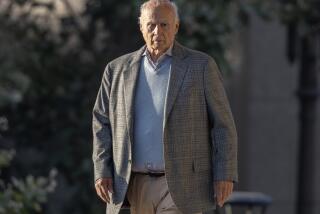Top Merrill Exec, Underlings Clash on Citron Account
- Share via
More than two years before Orange County’s bankruptcy, a top Merrill Lynch & Co. executive questioned the investments his firm provided the county and demanded assurances that they were legal and their risks publicly disclosed.
But David H. Komansky, now Merrill’s chairman, said in a deposition released Friday that in getting the results of the internal review, he was never told about some of the more serious problems that led to the nation’s biggest municipal failure.
His statements contradict other testimony and raise questions about whether Komansky and other Merrill executives shrugged off evidence of the risks being run by Merrill’s most lucrative client.
His testimony, released in response to requests by The Times and other news companies, also raises questions about whether underlings hid those risks from Komansky.
The deposition was given in the county’s lawsuit against Merrill and other brokerages and advisors over the $1.64 billion in investment losses that sparked the 1994 bankruptcy. Merrill has agreed to pay more than $460 million to settle the suit and related civil, criminal and regulatory actions.
Merrill contends Komansky acted properly, assessing the county’s account and assigning top executives to monitor it. The firm says it warned then-County Treasurer Robert L. Citron of the risks he was running, persuaded him to disclose his strategies publicly and offered to buy back billions of dollars in risky securities it had sold him--an offer Citron refused.
However, the issue of whether more information might have forced Komansky into more direct action--perhaps a direct approach to county supervisors, as some Merrill insiders had proposed--is raised indirectly in his testimony.
In one crucial case, for example, Komansky said he requested to see a key memo warning in detail about the risks the county faced from securities Merrill sold it and from Citron’s heavy borrowings to finance the purchases. But he said he never was given the memo.
A Komansky subordinate, Edson V. Mitchell, however, testified that he sent his boss a copy of the memo and discussed it with him later.
“How is it that one of the senior officers of Merrill Lynch asks for a copy of a document, and you don’t get it?” Orange County attorney James Mercer asked during the deposition last February.
“As we sit here today, I would like to know that,” Komansky replied. “I asked for it, I never saw it prior to the bankruptcy. It’s one of those things that slipped through.”
In his deposition, Komansky repeatedly denied learning about details of the heavy risks Citron was taking. Nor was he told, he said, how Michael G. Stamenson, the aggressive Merrill broker working with Citron, had used a similar strategy a decade earlier and lost $60 million for the city of San Jose.
Komansky, who once wrote a note calling Stamenson “the best there is,” acknowledged in the deposition that Stamenson made “a very basic mistake” in 1992 by selling Orange County and other municipalities foreign securities that were off-limits for such governments to hold.
However, Komansky said the salesman “was, and is, a very professional, accomplished person in what he does.” He characterized as “a bit of macho” salesmanship a videotaped Stamenson boast advising young brokers to “go into an account, get in his face, convince him to do something he wouldn’t normally do on his own and make it happen for big size.”
The county alleged in its lawsuit that voices of prudence at Merrill were disregarded because of the multimillion-dollar profits the company and Stamenson made on the Citron account.
Komansky held numerous positions with Merrill, which in April 1992 made him executive vice president of global debt markets, the division that handled Citron’s trades. He was promoted to president in 1995 and to chairman in 1997.
Komansky said that when he started his new job, he was unacquainted with Citron’s bold strategy of borrowing heavily to invest in interest-sensitive securities. The technique yielded huge returns in the early 1990s, making Citron a hero of municipal finance until the Federal Reserve Board raised rates six times in 1994, toppling his complicated investments.
Komansky said that at the time he wanted clarified several questions about the Orange County account, including whether Citron was authorized to engage in his strategies and whether the risks were disclosed to the county supervisors.
“I also had a very significant concern, since we are going through the concerns, who Citron was professionally. That was probably the foremost issue on my mind,” Komansky said.
After late 1992 meetings with top Merrill lawyer Stephen L. Hammerman, Komansky was reassured about the account, he testified. He said he never had another meeting about the county until after it filed its bankruptcy papers.
Other Merrill officials, meantime, went along with Citron’s insistence that they not take their concerns directly to county supervisors. Instead, they drafted a document to help Citron disclose the risks if interest rates should rise--language he included in his annual report in September 1993.
Komansky testified that he was supposed to have been kept posted on the account by one of the executives who raised concerns about Citron. But he later stopped getting information “as we moved forward and our concerns became less of a concern.”
Under questioning by Mercer, Komansky said he was never told that Citron’s borrowing costs could exceed his returns if interest rates rose. Nor, he said, was he told that Citron was using borrowed money to buy securities whose value was tied to Swiss interest rates and so-called inverse floaters--securities whose value would plummet if rates rose.
More to Read
Inside the business of entertainment
The Wide Shot brings you news, analysis and insights on everything from streaming wars to production — and what it all means for the future.
You may occasionally receive promotional content from the Los Angeles Times.











